An Economic Analysis: Is the Australian Dollar Currently Overvalued?
VerifiedAdded on 2020/03/28
|8
|2190
|33
Report
AI Summary
This report analyzes the valuation of the Australian dollar (AUD), examining whether it is overvalued. It explores various factors influencing the AUD, including commodity prices, the Reserve Bank of Australia's policies, and the impact of exchange rates on the Australian economy. The report discusses the concept of a floating exchange rate and its implications for investors, considering the effects of supply and demand in the forex market. It also delves into the benefits and drawbacks of an overvalued currency, such as its impact on exports, imports, and overall economic growth. Furthermore, the report touches upon the possibility of a fixed exchange rate and its potential effects on the AUD's stability and investor confidence. The analysis incorporates perspectives from economists and currency strategists, providing a comprehensive overview of the current state and future prospects of the Australian dollar.
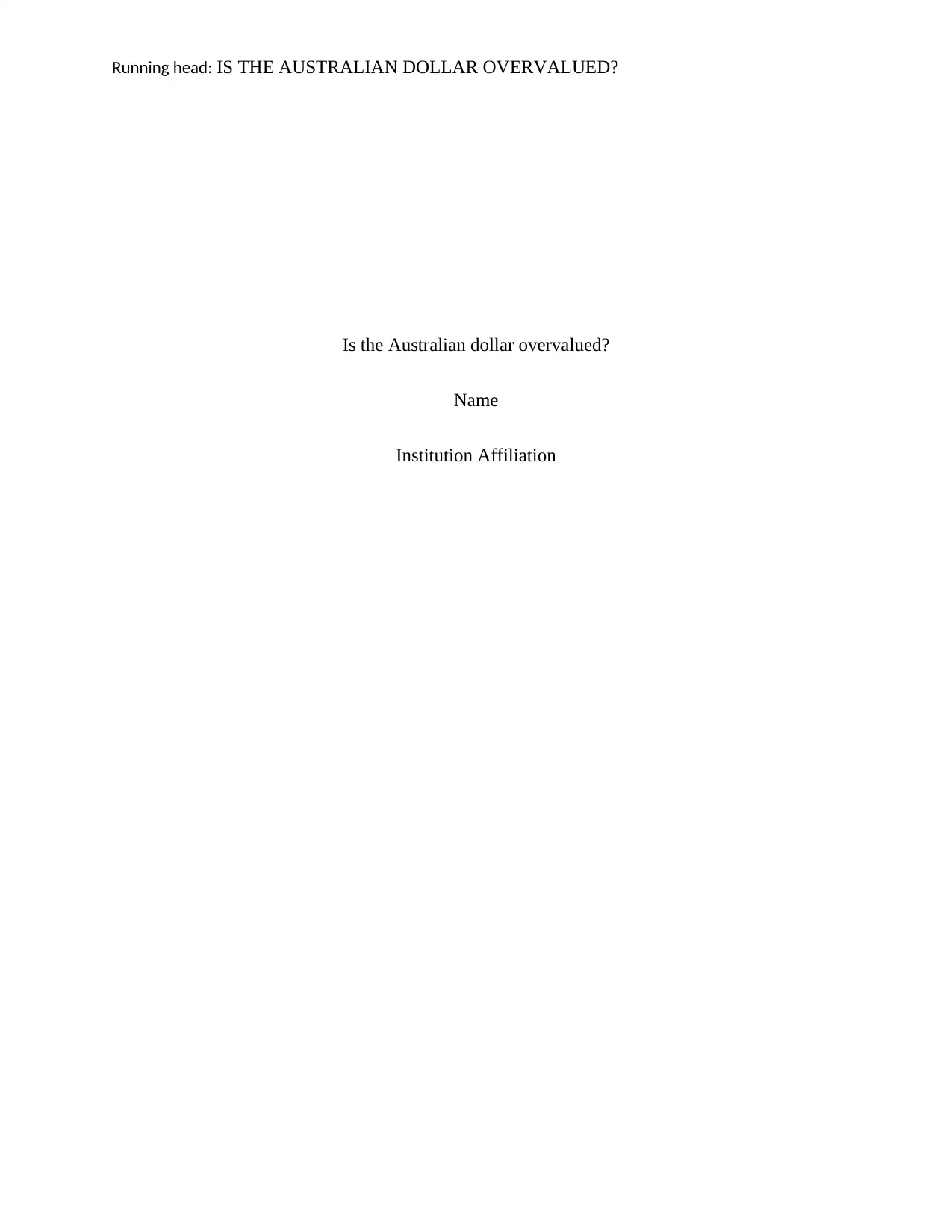
Running head: IS THE AUSTRALIAN DOLLAR OVERVALUED?
Is the Australian dollar overvalued?
Name
Institution Affiliation
Is the Australian dollar overvalued?
Name
Institution Affiliation
Paraphrase This Document
Need a fresh take? Get an instant paraphrase of this document with our AI Paraphraser
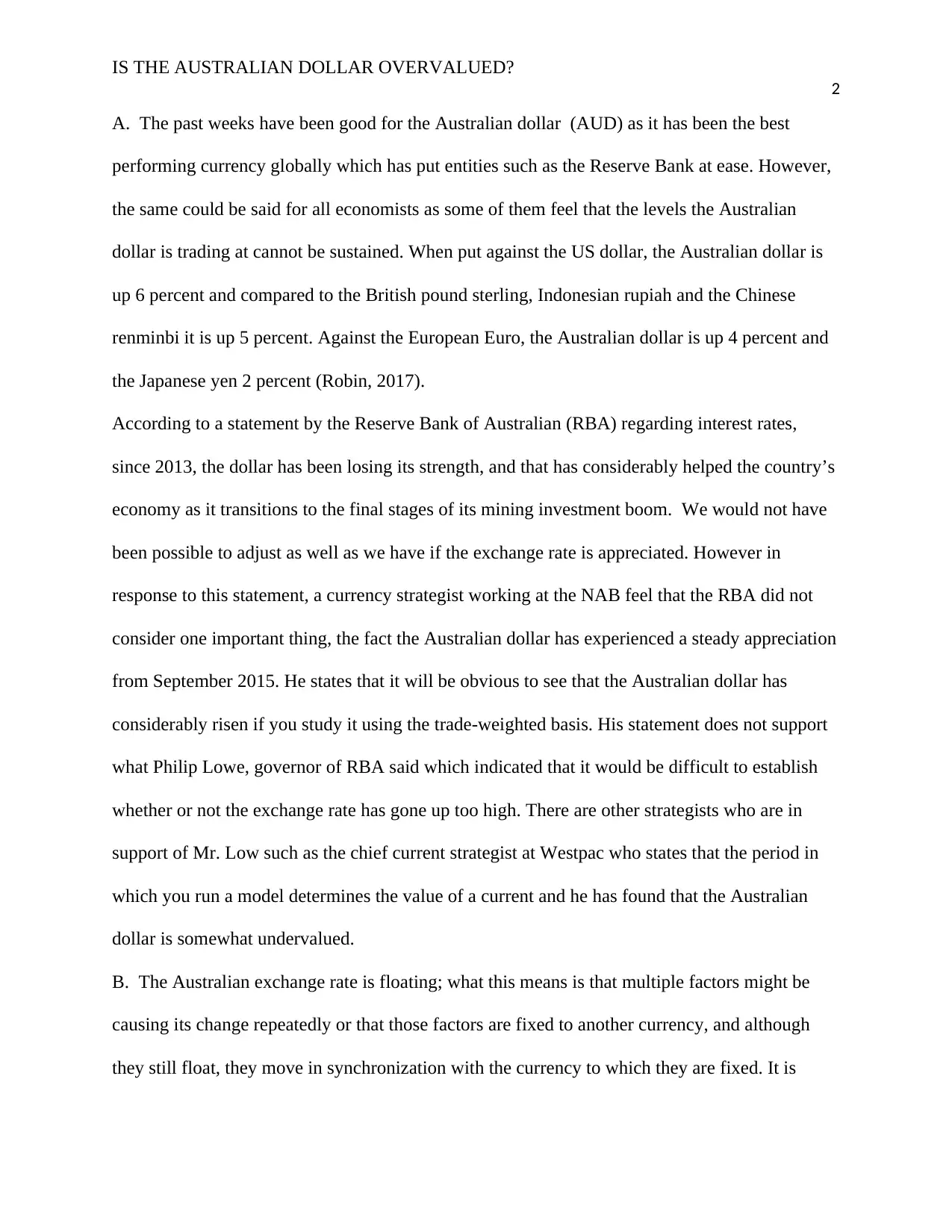
IS THE AUSTRALIAN DOLLAR OVERVALUED?
2
A. The past weeks have been good for the Australian dollar (AUD) as it has been the best
performing currency globally which has put entities such as the Reserve Bank at ease. However,
the same could be said for all economists as some of them feel that the levels the Australian
dollar is trading at cannot be sustained. When put against the US dollar, the Australian dollar is
up 6 percent and compared to the British pound sterling, Indonesian rupiah and the Chinese
renminbi it is up 5 percent. Against the European Euro, the Australian dollar is up 4 percent and
the Japanese yen 2 percent (Robin, 2017).
According to a statement by the Reserve Bank of Australian (RBA) regarding interest rates,
since 2013, the dollar has been losing its strength, and that has considerably helped the country’s
economy as it transitions to the final stages of its mining investment boom. We would not have
been possible to adjust as well as we have if the exchange rate is appreciated. However in
response to this statement, a currency strategist working at the NAB feel that the RBA did not
consider one important thing, the fact the Australian dollar has experienced a steady appreciation
from September 2015. He states that it will be obvious to see that the Australian dollar has
considerably risen if you study it using the trade-weighted basis. His statement does not support
what Philip Lowe, governor of RBA said which indicated that it would be difficult to establish
whether or not the exchange rate has gone up too high. There are other strategists who are in
support of Mr. Low such as the chief current strategist at Westpac who states that the period in
which you run a model determines the value of a current and he has found that the Australian
dollar is somewhat undervalued.
B. The Australian exchange rate is floating; what this means is that multiple factors might be
causing its change repeatedly or that those factors are fixed to another currency, and although
they still float, they move in synchronization with the currency to which they are fixed. It is
2
A. The past weeks have been good for the Australian dollar (AUD) as it has been the best
performing currency globally which has put entities such as the Reserve Bank at ease. However,
the same could be said for all economists as some of them feel that the levels the Australian
dollar is trading at cannot be sustained. When put against the US dollar, the Australian dollar is
up 6 percent and compared to the British pound sterling, Indonesian rupiah and the Chinese
renminbi it is up 5 percent. Against the European Euro, the Australian dollar is up 4 percent and
the Japanese yen 2 percent (Robin, 2017).
According to a statement by the Reserve Bank of Australian (RBA) regarding interest rates,
since 2013, the dollar has been losing its strength, and that has considerably helped the country’s
economy as it transitions to the final stages of its mining investment boom. We would not have
been possible to adjust as well as we have if the exchange rate is appreciated. However in
response to this statement, a currency strategist working at the NAB feel that the RBA did not
consider one important thing, the fact the Australian dollar has experienced a steady appreciation
from September 2015. He states that it will be obvious to see that the Australian dollar has
considerably risen if you study it using the trade-weighted basis. His statement does not support
what Philip Lowe, governor of RBA said which indicated that it would be difficult to establish
whether or not the exchange rate has gone up too high. There are other strategists who are in
support of Mr. Low such as the chief current strategist at Westpac who states that the period in
which you run a model determines the value of a current and he has found that the Australian
dollar is somewhat undervalued.
B. The Australian exchange rate is floating; what this means is that multiple factors might be
causing its change repeatedly or that those factors are fixed to another currency, and although
they still float, they move in synchronization with the currency to which they are fixed. It is
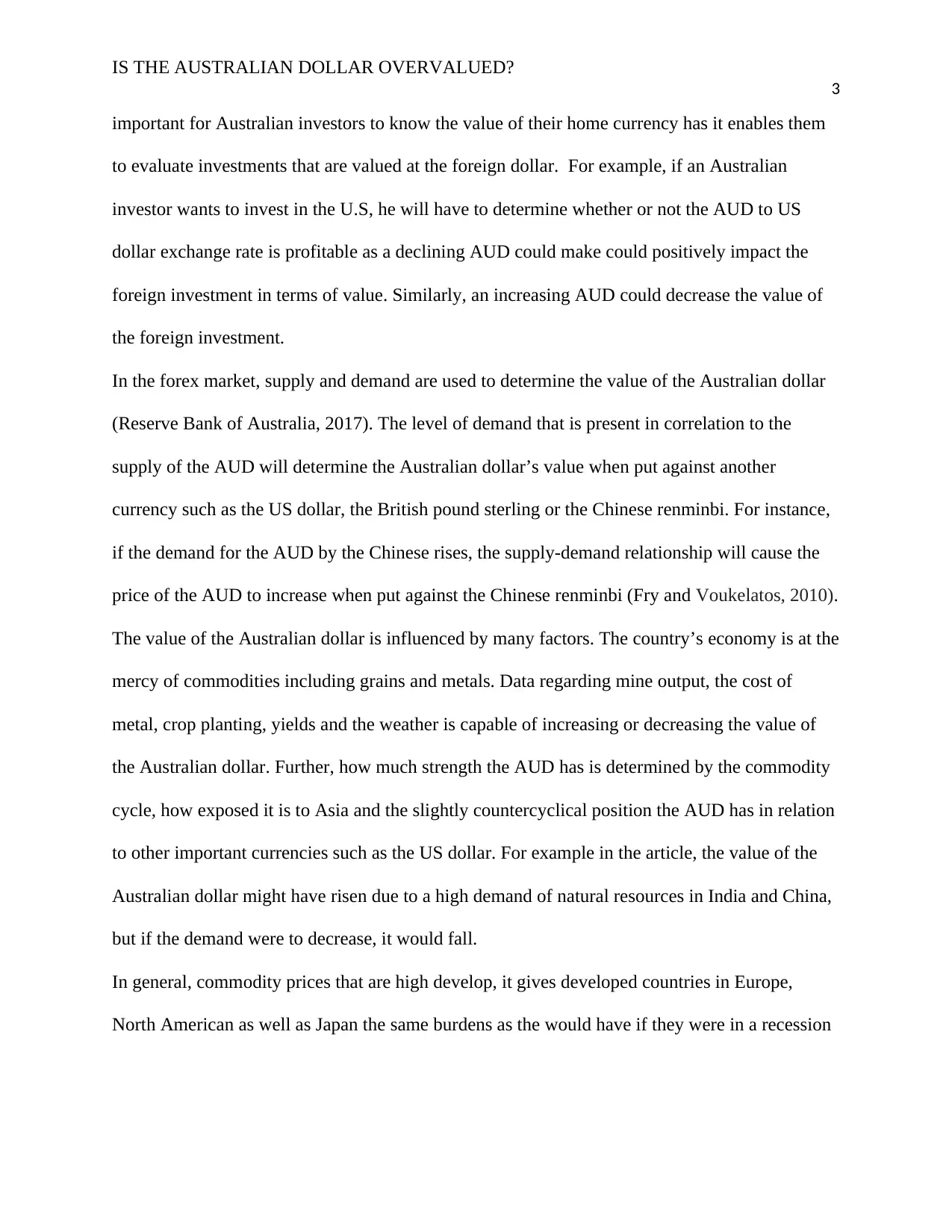
IS THE AUSTRALIAN DOLLAR OVERVALUED?
3
important for Australian investors to know the value of their home currency has it enables them
to evaluate investments that are valued at the foreign dollar. For example, if an Australian
investor wants to invest in the U.S, he will have to determine whether or not the AUD to US
dollar exchange rate is profitable as a declining AUD could make could positively impact the
foreign investment in terms of value. Similarly, an increasing AUD could decrease the value of
the foreign investment.
In the forex market, supply and demand are used to determine the value of the Australian dollar
(Reserve Bank of Australia, 2017). The level of demand that is present in correlation to the
supply of the AUD will determine the Australian dollar’s value when put against another
currency such as the US dollar, the British pound sterling or the Chinese renminbi. For instance,
if the demand for the AUD by the Chinese rises, the supply-demand relationship will cause the
price of the AUD to increase when put against the Chinese renminbi (Fry and Voukelatos, 2010).
The value of the Australian dollar is influenced by many factors. The country’s economy is at the
mercy of commodities including grains and metals. Data regarding mine output, the cost of
metal, crop planting, yields and the weather is capable of increasing or decreasing the value of
the Australian dollar. Further, how much strength the AUD has is determined by the commodity
cycle, how exposed it is to Asia and the slightly countercyclical position the AUD has in relation
to other important currencies such as the US dollar. For example in the article, the value of the
Australian dollar might have risen due to a high demand of natural resources in India and China,
but if the demand were to decrease, it would fall.
In general, commodity prices that are high develop, it gives developed countries in Europe,
North American as well as Japan the same burdens as the would have if they were in a recession
3
important for Australian investors to know the value of their home currency has it enables them
to evaluate investments that are valued at the foreign dollar. For example, if an Australian
investor wants to invest in the U.S, he will have to determine whether or not the AUD to US
dollar exchange rate is profitable as a declining AUD could make could positively impact the
foreign investment in terms of value. Similarly, an increasing AUD could decrease the value of
the foreign investment.
In the forex market, supply and demand are used to determine the value of the Australian dollar
(Reserve Bank of Australia, 2017). The level of demand that is present in correlation to the
supply of the AUD will determine the Australian dollar’s value when put against another
currency such as the US dollar, the British pound sterling or the Chinese renminbi. For instance,
if the demand for the AUD by the Chinese rises, the supply-demand relationship will cause the
price of the AUD to increase when put against the Chinese renminbi (Fry and Voukelatos, 2010).
The value of the Australian dollar is influenced by many factors. The country’s economy is at the
mercy of commodities including grains and metals. Data regarding mine output, the cost of
metal, crop planting, yields and the weather is capable of increasing or decreasing the value of
the Australian dollar. Further, how much strength the AUD has is determined by the commodity
cycle, how exposed it is to Asia and the slightly countercyclical position the AUD has in relation
to other important currencies such as the US dollar. For example in the article, the value of the
Australian dollar might have risen due to a high demand of natural resources in India and China,
but if the demand were to decrease, it would fall.
In general, commodity prices that are high develop, it gives developed countries in Europe,
North American as well as Japan the same burdens as the would have if they were in a recession
⊘ This is a preview!⊘
Do you want full access?
Subscribe today to unlock all pages.

Trusted by 1+ million students worldwide
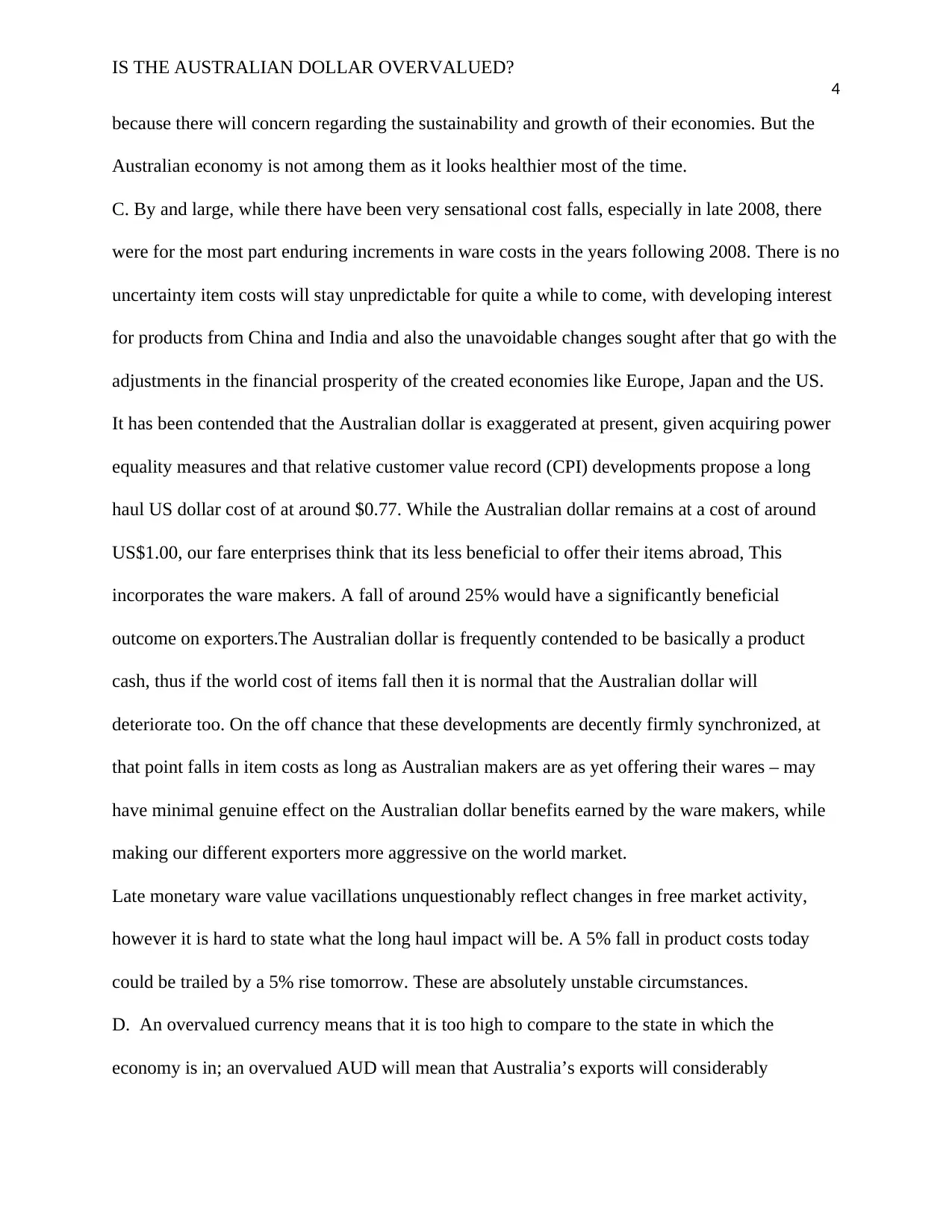
IS THE AUSTRALIAN DOLLAR OVERVALUED?
4
because there will concern regarding the sustainability and growth of their economies. But the
Australian economy is not among them as it looks healthier most of the time.
C. By and large, while there have been very sensational cost falls, especially in late 2008, there
were for the most part enduring increments in ware costs in the years following 2008. There is no
uncertainty item costs will stay unpredictable for quite a while to come, with developing interest
for products from China and India and also the unavoidable changes sought after that go with the
adjustments in the financial prosperity of the created economies like Europe, Japan and the US.
It has been contended that the Australian dollar is exaggerated at present, given acquiring power
equality measures and that relative customer value record (CPI) developments propose a long
haul US dollar cost of at around $0.77. While the Australian dollar remains at a cost of around
US$1.00, our fare enterprises think that its less beneficial to offer their items abroad, This
incorporates the ware makers. A fall of around 25% would have a significantly beneficial
outcome on exporters.The Australian dollar is frequently contended to be basically a product
cash, thus if the world cost of items fall then it is normal that the Australian dollar will
deteriorate too. On the off chance that these developments are decently firmly synchronized, at
that point falls in item costs as long as Australian makers are as yet offering their wares – may
have minimal genuine effect on the Australian dollar benefits earned by the ware makers, while
making our different exporters more aggressive on the world market.
Late monetary ware value vacillations unquestionably reflect changes in free market activity,
however it is hard to state what the long haul impact will be. A 5% fall in product costs today
could be trailed by a 5% rise tomorrow. These are absolutely unstable circumstances.
D. An overvalued currency means that it is too high to compare to the state in which the
economy is in; an overvalued AUD will mean that Australia’s exports will considerably
4
because there will concern regarding the sustainability and growth of their economies. But the
Australian economy is not among them as it looks healthier most of the time.
C. By and large, while there have been very sensational cost falls, especially in late 2008, there
were for the most part enduring increments in ware costs in the years following 2008. There is no
uncertainty item costs will stay unpredictable for quite a while to come, with developing interest
for products from China and India and also the unavoidable changes sought after that go with the
adjustments in the financial prosperity of the created economies like Europe, Japan and the US.
It has been contended that the Australian dollar is exaggerated at present, given acquiring power
equality measures and that relative customer value record (CPI) developments propose a long
haul US dollar cost of at around $0.77. While the Australian dollar remains at a cost of around
US$1.00, our fare enterprises think that its less beneficial to offer their items abroad, This
incorporates the ware makers. A fall of around 25% would have a significantly beneficial
outcome on exporters.The Australian dollar is frequently contended to be basically a product
cash, thus if the world cost of items fall then it is normal that the Australian dollar will
deteriorate too. On the off chance that these developments are decently firmly synchronized, at
that point falls in item costs as long as Australian makers are as yet offering their wares – may
have minimal genuine effect on the Australian dollar benefits earned by the ware makers, while
making our different exporters more aggressive on the world market.
Late monetary ware value vacillations unquestionably reflect changes in free market activity,
however it is hard to state what the long haul impact will be. A 5% fall in product costs today
could be trailed by a 5% rise tomorrow. These are absolutely unstable circumstances.
D. An overvalued currency means that it is too high to compare to the state in which the
economy is in; an overvalued AUD will mean that Australia’s exports will considerably
Paraphrase This Document
Need a fresh take? Get an instant paraphrase of this document with our AI Paraphraser
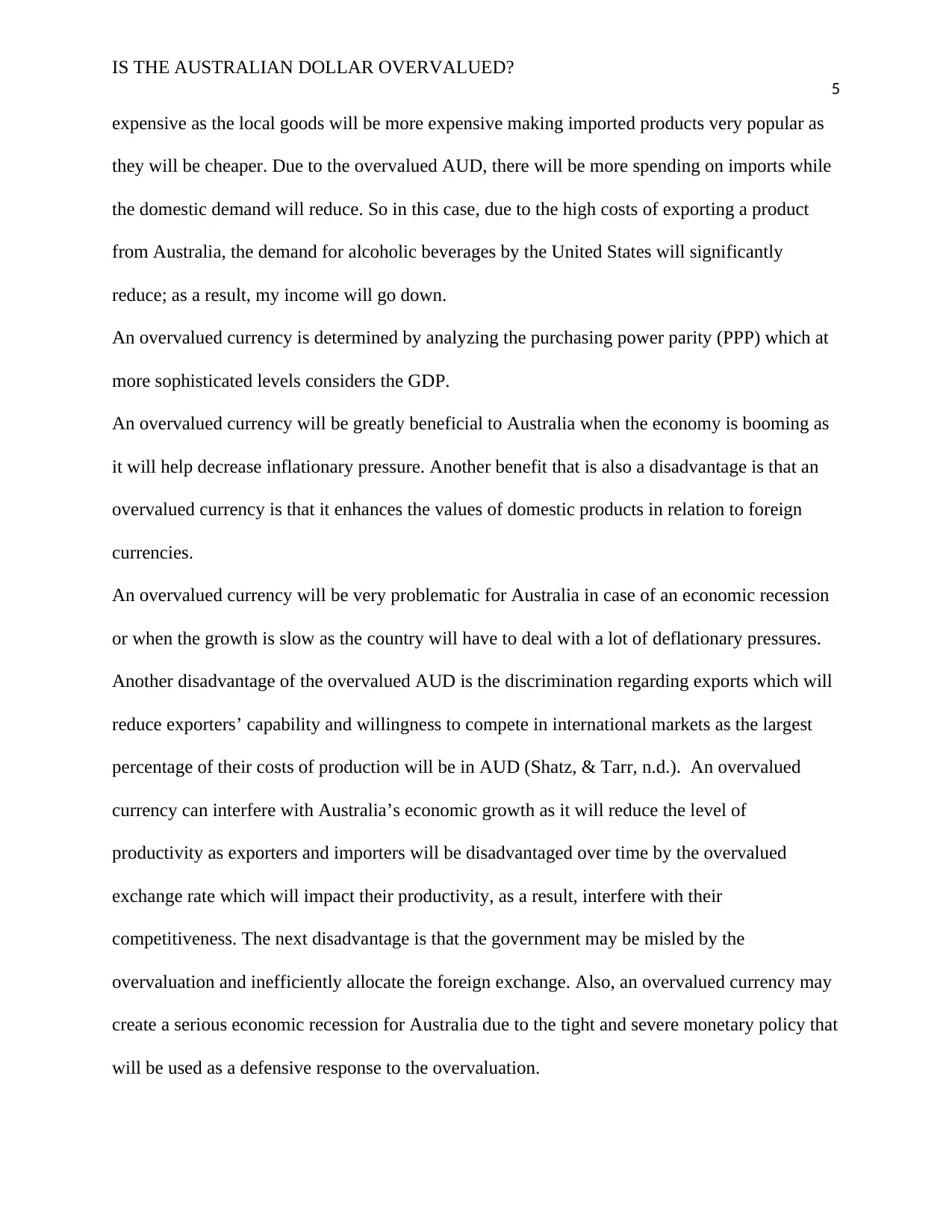
IS THE AUSTRALIAN DOLLAR OVERVALUED?
5
expensive as the local goods will be more expensive making imported products very popular as
they will be cheaper. Due to the overvalued AUD, there will be more spending on imports while
the domestic demand will reduce. So in this case, due to the high costs of exporting a product
from Australia, the demand for alcoholic beverages by the United States will significantly
reduce; as a result, my income will go down.
An overvalued currency is determined by analyzing the purchasing power parity (PPP) which at
more sophisticated levels considers the GDP.
An overvalued currency will be greatly beneficial to Australia when the economy is booming as
it will help decrease inflationary pressure. Another benefit that is also a disadvantage is that an
overvalued currency is that it enhances the values of domestic products in relation to foreign
currencies.
An overvalued currency will be very problematic for Australia in case of an economic recession
or when the growth is slow as the country will have to deal with a lot of deflationary pressures.
Another disadvantage of the overvalued AUD is the discrimination regarding exports which will
reduce exporters’ capability and willingness to compete in international markets as the largest
percentage of their costs of production will be in AUD (Shatz, & Tarr, n.d.). An overvalued
currency can interfere with Australia’s economic growth as it will reduce the level of
productivity as exporters and importers will be disadvantaged over time by the overvalued
exchange rate which will impact their productivity, as a result, interfere with their
competitiveness. The next disadvantage is that the government may be misled by the
overvaluation and inefficiently allocate the foreign exchange. Also, an overvalued currency may
create a serious economic recession for Australia due to the tight and severe monetary policy that
will be used as a defensive response to the overvaluation.
5
expensive as the local goods will be more expensive making imported products very popular as
they will be cheaper. Due to the overvalued AUD, there will be more spending on imports while
the domestic demand will reduce. So in this case, due to the high costs of exporting a product
from Australia, the demand for alcoholic beverages by the United States will significantly
reduce; as a result, my income will go down.
An overvalued currency is determined by analyzing the purchasing power parity (PPP) which at
more sophisticated levels considers the GDP.
An overvalued currency will be greatly beneficial to Australia when the economy is booming as
it will help decrease inflationary pressure. Another benefit that is also a disadvantage is that an
overvalued currency is that it enhances the values of domestic products in relation to foreign
currencies.
An overvalued currency will be very problematic for Australia in case of an economic recession
or when the growth is slow as the country will have to deal with a lot of deflationary pressures.
Another disadvantage of the overvalued AUD is the discrimination regarding exports which will
reduce exporters’ capability and willingness to compete in international markets as the largest
percentage of their costs of production will be in AUD (Shatz, & Tarr, n.d.). An overvalued
currency can interfere with Australia’s economic growth as it will reduce the level of
productivity as exporters and importers will be disadvantaged over time by the overvalued
exchange rate which will impact their productivity, as a result, interfere with their
competitiveness. The next disadvantage is that the government may be misled by the
overvaluation and inefficiently allocate the foreign exchange. Also, an overvalued currency may
create a serious economic recession for Australia due to the tight and severe monetary policy that
will be used as a defensive response to the overvaluation.
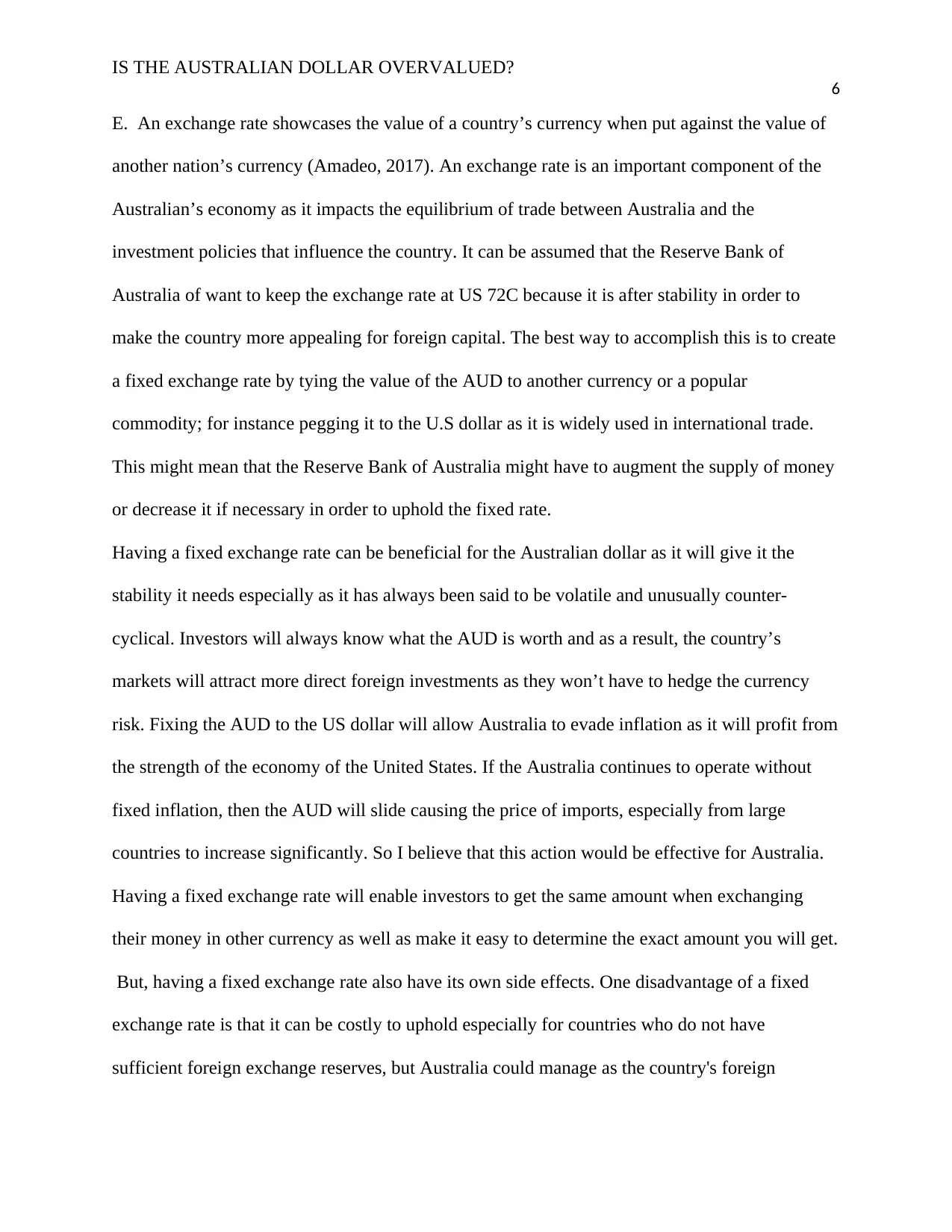
IS THE AUSTRALIAN DOLLAR OVERVALUED?
6
E. An exchange rate showcases the value of a country’s currency when put against the value of
another nation’s currency (Amadeo, 2017). An exchange rate is an important component of the
Australian’s economy as it impacts the equilibrium of trade between Australia and the
investment policies that influence the country. It can be assumed that the Reserve Bank of
Australia of want to keep the exchange rate at US 72C because it is after stability in order to
make the country more appealing for foreign capital. The best way to accomplish this is to create
a fixed exchange rate by tying the value of the AUD to another currency or a popular
commodity; for instance pegging it to the U.S dollar as it is widely used in international trade.
This might mean that the Reserve Bank of Australia might have to augment the supply of money
or decrease it if necessary in order to uphold the fixed rate.
Having a fixed exchange rate can be beneficial for the Australian dollar as it will give it the
stability it needs especially as it has always been said to be volatile and unusually counter-
cyclical. Investors will always know what the AUD is worth and as a result, the country’s
markets will attract more direct foreign investments as they won’t have to hedge the currency
risk. Fixing the AUD to the US dollar will allow Australia to evade inflation as it will profit from
the strength of the economy of the United States. If the Australia continues to operate without
fixed inflation, then the AUD will slide causing the price of imports, especially from large
countries to increase significantly. So I believe that this action would be effective for Australia.
Having a fixed exchange rate will enable investors to get the same amount when exchanging
their money in other currency as well as make it easy to determine the exact amount you will get.
But, having a fixed exchange rate also have its own side effects. One disadvantage of a fixed
exchange rate is that it can be costly to uphold especially for countries who do not have
sufficient foreign exchange reserves, but Australia could manage as the country's foreign
6
E. An exchange rate showcases the value of a country’s currency when put against the value of
another nation’s currency (Amadeo, 2017). An exchange rate is an important component of the
Australian’s economy as it impacts the equilibrium of trade between Australia and the
investment policies that influence the country. It can be assumed that the Reserve Bank of
Australia of want to keep the exchange rate at US 72C because it is after stability in order to
make the country more appealing for foreign capital. The best way to accomplish this is to create
a fixed exchange rate by tying the value of the AUD to another currency or a popular
commodity; for instance pegging it to the U.S dollar as it is widely used in international trade.
This might mean that the Reserve Bank of Australia might have to augment the supply of money
or decrease it if necessary in order to uphold the fixed rate.
Having a fixed exchange rate can be beneficial for the Australian dollar as it will give it the
stability it needs especially as it has always been said to be volatile and unusually counter-
cyclical. Investors will always know what the AUD is worth and as a result, the country’s
markets will attract more direct foreign investments as they won’t have to hedge the currency
risk. Fixing the AUD to the US dollar will allow Australia to evade inflation as it will profit from
the strength of the economy of the United States. If the Australia continues to operate without
fixed inflation, then the AUD will slide causing the price of imports, especially from large
countries to increase significantly. So I believe that this action would be effective for Australia.
Having a fixed exchange rate will enable investors to get the same amount when exchanging
their money in other currency as well as make it easy to determine the exact amount you will get.
But, having a fixed exchange rate also have its own side effects. One disadvantage of a fixed
exchange rate is that it can be costly to uphold especially for countries who do not have
sufficient foreign exchange reserves, but Australia could manage as the country's foreign
⊘ This is a preview!⊘
Do you want full access?
Subscribe today to unlock all pages.

Trusted by 1+ million students worldwide
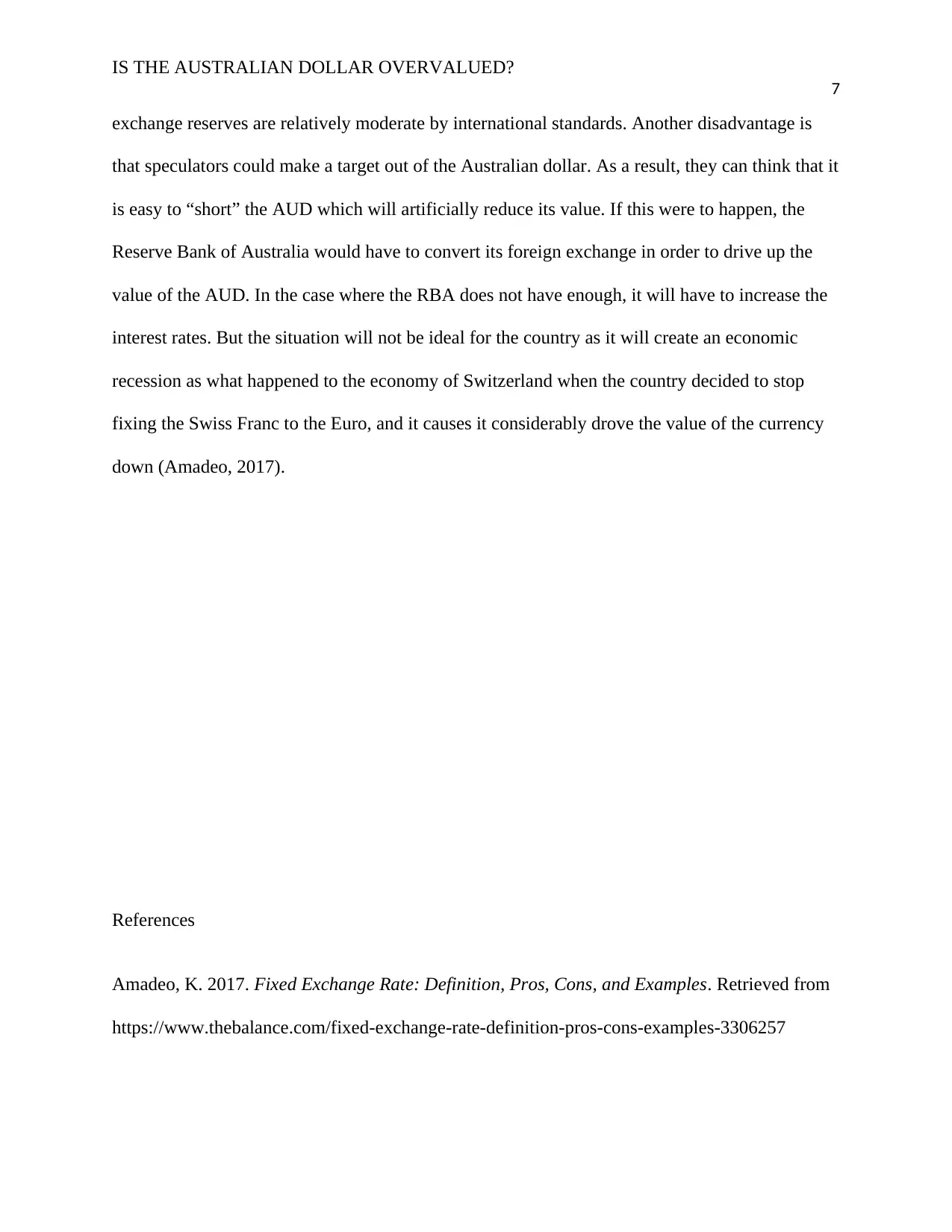
IS THE AUSTRALIAN DOLLAR OVERVALUED?
7
exchange reserves are relatively moderate by international standards. Another disadvantage is
that speculators could make a target out of the Australian dollar. As a result, they can think that it
is easy to “short” the AUD which will artificially reduce its value. If this were to happen, the
Reserve Bank of Australia would have to convert its foreign exchange in order to drive up the
value of the AUD. In the case where the RBA does not have enough, it will have to increase the
interest rates. But the situation will not be ideal for the country as it will create an economic
recession as what happened to the economy of Switzerland when the country decided to stop
fixing the Swiss Franc to the Euro, and it causes it considerably drove the value of the currency
down (Amadeo, 2017).
References
Amadeo, K. 2017. Fixed Exchange Rate: Definition, Pros, Cons, and Examples. Retrieved from
https://www.thebalance.com/fixed-exchange-rate-definition-pros-cons-examples-3306257
7
exchange reserves are relatively moderate by international standards. Another disadvantage is
that speculators could make a target out of the Australian dollar. As a result, they can think that it
is easy to “short” the AUD which will artificially reduce its value. If this were to happen, the
Reserve Bank of Australia would have to convert its foreign exchange in order to drive up the
value of the AUD. In the case where the RBA does not have enough, it will have to increase the
interest rates. But the situation will not be ideal for the country as it will create an economic
recession as what happened to the economy of Switzerland when the country decided to stop
fixing the Swiss Franc to the Euro, and it causes it considerably drove the value of the currency
down (Amadeo, 2017).
References
Amadeo, K. 2017. Fixed Exchange Rate: Definition, Pros, Cons, and Examples. Retrieved from
https://www.thebalance.com/fixed-exchange-rate-definition-pros-cons-examples-3306257
Paraphrase This Document
Need a fresh take? Get an instant paraphrase of this document with our AI Paraphraser
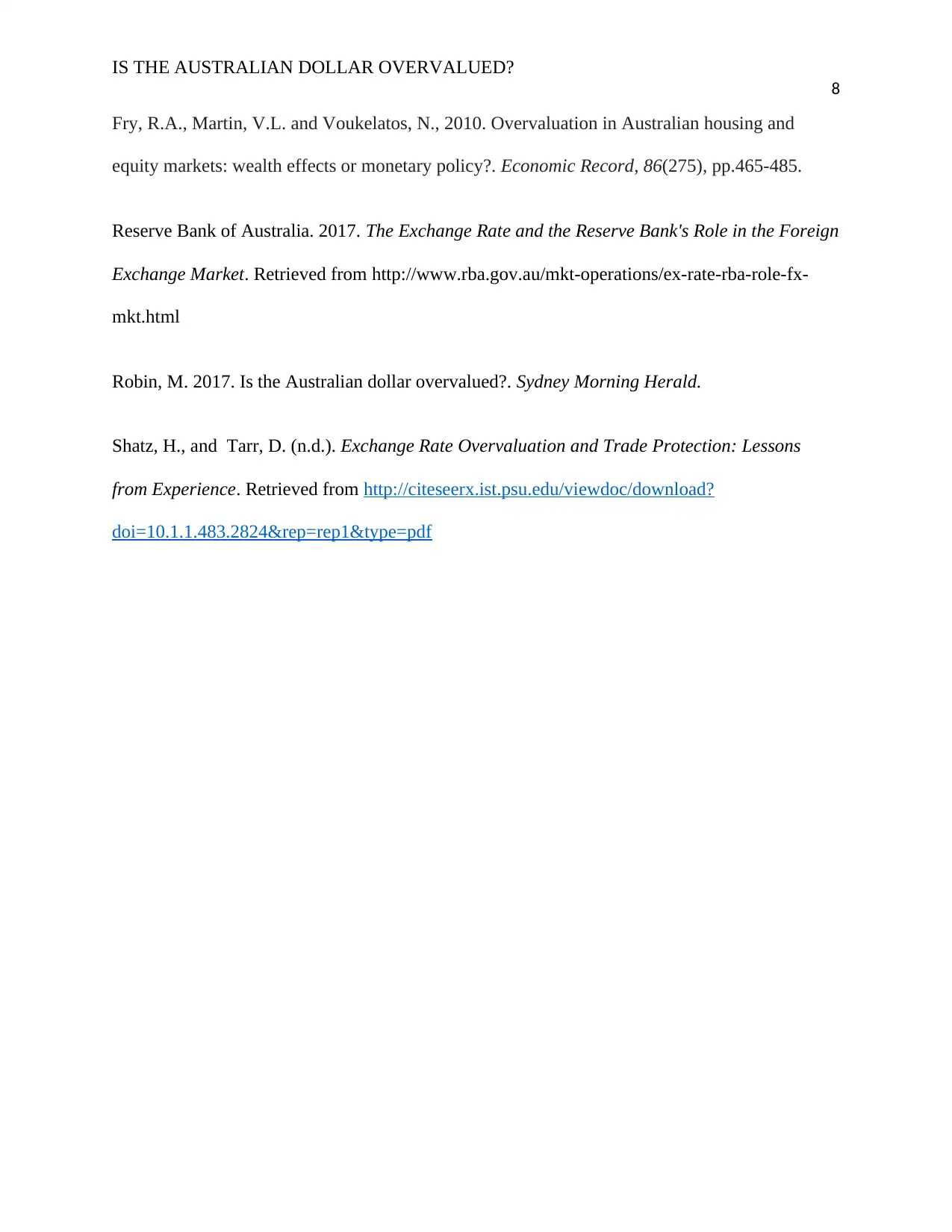
IS THE AUSTRALIAN DOLLAR OVERVALUED?
8
Fry, R.A., Martin, V.L. and Voukelatos, N., 2010. Overvaluation in Australian housing and
equity markets: wealth effects or monetary policy?. Economic Record, 86(275), pp.465-485.
Reserve Bank of Australia. 2017. The Exchange Rate and the Reserve Bank's Role in the Foreign
Exchange Market. Retrieved from http://www.rba.gov.au/mkt-operations/ex-rate-rba-role-fx-
mkt.html
Robin, M. 2017. Is the Australian dollar overvalued?. Sydney Morning Herald.
Shatz, H., and Tarr, D. (n.d.). Exchange Rate Overvaluation and Trade Protection: Lessons
from Experience. Retrieved from http://citeseerx.ist.psu.edu/viewdoc/download?
doi=10.1.1.483.2824&rep=rep1&type=pdf
8
Fry, R.A., Martin, V.L. and Voukelatos, N., 2010. Overvaluation in Australian housing and
equity markets: wealth effects or monetary policy?. Economic Record, 86(275), pp.465-485.
Reserve Bank of Australia. 2017. The Exchange Rate and the Reserve Bank's Role in the Foreign
Exchange Market. Retrieved from http://www.rba.gov.au/mkt-operations/ex-rate-rba-role-fx-
mkt.html
Robin, M. 2017. Is the Australian dollar overvalued?. Sydney Morning Herald.
Shatz, H., and Tarr, D. (n.d.). Exchange Rate Overvaluation and Trade Protection: Lessons
from Experience. Retrieved from http://citeseerx.ist.psu.edu/viewdoc/download?
doi=10.1.1.483.2824&rep=rep1&type=pdf
1 out of 8
Related Documents
Your All-in-One AI-Powered Toolkit for Academic Success.
+13062052269
info@desklib.com
Available 24*7 on WhatsApp / Email
![[object Object]](/_next/static/media/star-bottom.7253800d.svg)
Unlock your academic potential
Copyright © 2020–2025 A2Z Services. All Rights Reserved. Developed and managed by ZUCOL.





